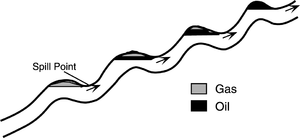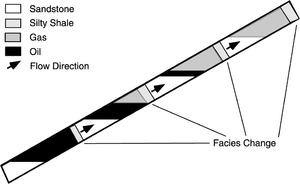Postprimary migration and compositional changes
| Exploring for Oil and Gas Traps | |

| |
| Series | Treatise in Petroleum Geology |
|---|---|
| Part | Critical elements of the petroleum system |
| Chapter | Migration of petroleum |
| Author | Martin D. Matthews |
| Link | Web page |
| Store | AAPG Store |
During postexpulsion migration, many processes can alter the chemical characteristics of the hydrocarbons expelled from the source rock. The geochemical similarity of reservoired hydrocarbons and hydrocarbons expelled from source rocks, however, indicates there is usually little compositional alteration along the postexpulsion migration routes. An exception to this is the selective trapping of gas- and liquid-rich phases due to the quality of the seal.
Alteration processes
Processes responsible for altering the composition of hydrocarbons during migration include the following:
- Water-washing—selective removal of the more water-soluble components
- Adsorption—selective removal and retardation of hydrocarbon migration rate by mineral and kerogen particles
- Phase partitioning—concentration of different hydrocarbon species into gaseous and liquid phases with changes in pressure and temperature
- Mixing—by (1) including hydrocarbons from kerogen particles along the migration path; (2) mixing migration streams from two or more source rocks; or (3) precipitation of asphaltenes and other high-molecular-weight compounds by the addition of methane
- Biodegradation—biologic alteration of the hydrocarbons
Migration method and alteration
The migration method partly determines the extent of compositional changes that occur during secondary or tertiary migration, or remigraton. If the petroleum moves as a broad front—as would be expected for solution gas or light oil in water and perhaps for dispersed colloids or droplets—there would be a maximum probability of interactions. However, if the petroleum moved as a slug or filament, contact with elements that could alter its composition would be more limited.
Seal leakage from traps with gas caps
In traps with gas caps, the buoyancy of the gas and oil column can exceed the breakthrough pressure of the seal prior to the trap being filled to the spill point. If this happens, the trap will leak through the seal and preferentially lose the gas phase. This situation (deep oil, shallow gas) is observed but is opposite to the expected sequence of entrapment due to maturation (oil migrates first, then gas). Figure 1 illustrates what happens when seals leak from traps with gas caps.
Differential entrapment

The differential entrapment of gas in downdip traps[2] is achieved by successively filling a sequence of traps in the same formation with oil and gas. As each trap fills to its spill point, the phase that is spilled first is the liquid leg. Thus, the gas is retained in the structurally lower traps and the oil is trapped farther up the migration path. This situation is the expected sequence of entrapment (shallow oil, deep gas) from the maturation sequence. Figure 2 illustrates what happens when traps preferentially spill oil and retain gas.
See also
References
- ↑ Schowalter, T. T., 1979, Mechanics of secondary hydrocarbon migration and entrapment: AAPG Bulletin, vol. 63, p. 723–760.
- ↑ 2.0 2.1 Gussow, W. C., 1954, Differential entrapment of gas and oil: a fundamental principle: AAPG Bulletin, vol. 38, p. 816–853.
